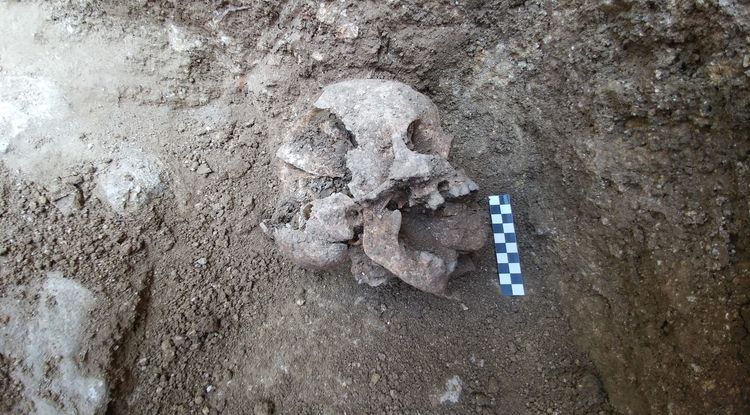
Archaeologists discovered the remains of a 10-year-old child in what is believed to be a rare case of a so-called "vampire burial." The child's skeleton was found with a rock in its mouth at the Cemetery of the Babies burial site in Lugnano, Teverina, central Italy.
The cemetery dates back to the mid-fifth century A.D., when a malaria epidemic tore through the Italian region of Umbria. It was built on the site of an abandoned first-century B.C. Roman villa. This was the first time excavators found a child with a stone in its mouth at the site, reported the University of Arizona.
Experts believed the stone may have been positioned as part of a superstitious "vampire burial" funeral rite to stop the body from rising from the dead and continuing the spread of the disease which killed it. Teams of archaeologists at the University of Arizona, Stanford University and institutions in Italy uncovered the body in the summer.
The body was positioned on its left side between two roof tiles leaning on a wall. It was buried in the alla cappuccina style widely seen in ancient Rome. As the mouth does not generally open when a body decomposes on its side, the rock was likely placed inside the child's mouth after it died, explained Jordan Wilson, an anthropology Ph.D. at the University of Arizona who assessed the remains. Teeth marks on the stone further supported the theory, she said.
David Pickel, excavation director and a Ph.D. candidate at Stanford, told Newsweek the limestone rock was around the size of an egg, measuring 7x4 centimeters, weighing 91 grams and carved to be pointed at the end.
"[I was surpirsed by] the seeming ritual practice involved in his or her burial," said Pickel. "The community did not simply insert a stone within this child's mouth; they first cut the stone, and then cemented it within the child's mouth." Dotted on the stone were "tooth-shaped depressions, similar to when one bites into a pastry."
The teeth from the remains were used to determine the child's age: about 10 years old. While the body awaits DNA testing to determine its cause of death, an abscess in the tooth suggested the child was a victim of malaria.
Dr. David Soren, professor at the University of Arizona School of Anthropology and Department of Religious Studies and Classics, said in a statement that "I've never seen anything like it. It's extremely eerie and weird. Locals have dubbed the 10-year-old the 'Vampire of Lugnano.'"
Soren told Newsweek, "Of significance is the opportunity to observe how a community caught up in a devastating epidemic responded to what to them was an unknown terror.
"The use of magic and witchcraft—in a sense, a return to non-Christian practices of earlier times—was seen as a way to deal with the aborting fetuses, terrible fevers and deaths," said Soren, who has worked on the site for the past three decades.
Wilson explained in a statement: "This is a very unusual mortuary treatment that you see in various forms in different cultures, especially in the Roman world, that could indicate there was a fear that this person might come back from the dead and try to spread disease to the living."
Read more: Rock used as doorstop for 30 years discovered to be $100k meteorite
Pickel said, "Knowing that two large roof tiles were used for this burial, I was expecting something unique to be found inside, perhaps a 'double-inhumation'—not uncommon for this cemetery—where a single burial contains two individuals."
Referring to the fact that only babies and toddlers had been found at the cemetery so far, he said, "After removing the roof tiles, however, it became immediately clear to us that we were dealing with an older individual."
The body is the latest clue to shed light on how Umbria's locals attempted to stem the spread of malaria, with archaeologists previously finding children buried alongside ash-filled cauldrons, puppies' remains, raven claws and toad bones in apparent attempts to combat the disease at a time when such conditions were poorly understood.
"Raven talons, toads, sacrifices and offerings in large bronze cauldrons, and even five- to six-month-old puppies being split in two and having their jaws ripped off, were part of these rites to try to expiate the unknown disease which we know now was malaria," said Soren.
This article has been updated with comment from David Pickel.
Uncommon Knowledge
Newsweek is committed to challenging conventional wisdom and finding connections in the search for common ground.
Newsweek is committed to challenging conventional wisdom and finding connections in the search for common ground.
About the writer
Kashmira Gander is Deputy Science Editor at Newsweek. Her interests include health, gender, LGBTQIA+ issues, human rights, subcultures, music, and lifestyle. Her ... Read more
To read how Newsweek uses AI as a newsroom tool, Click here.








